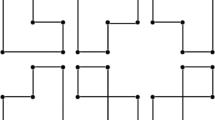Abstract
In this paper, we investigate the construction of time-varying convolutional low-density paritycheck (LDPC) codes derived from block LDPC codes based on improved progressive edge growth (PEG) method. Different from the conventional PEG algorithm, the parity-check matrix is initialized by inserting certain patterns. More specifically, the submatrices along the main diagonal are fixed to be the identity matrix that ensures the fast encoding feature of the LDPC convolutional codes. Second, we insert a nonzero pattern into the secondary diagonal submatrices that ensures the encoding memory length of the time-varying LDPC convolutional codes as large as possible. With this semi-random structure, we have analyzed the code performance by evaluating the number of short cycles as well as the the bound of free distance. Simulation results show that the constructed LDPC convolutional codes perform well over additive white Gaussian noise (AWGN) channels.
Similar content being viewed by others
References
Gallager R G. Low-density parity-check codes. IRE Trans Inform Theory, 1962, IT-8: 21–28
Wiberg N. Codes and decoding on general graphs. Dissertation for the Doctoral Degree. Sweden: Linkoping University, 1996. 7–10
MacKay D J C, Neal R M. Near Shannon limit performance of low density parity check codes. Electron Lett, 1996, 32: 1645–1646
Tanner R M. Error-correcting codes system. US: Patent 4295218, 1981
Felström A J, Zigangirov K S. Time-varying periodic convolutional codes with low-density parity-check matrix. IEEE Trans Inform Theory, 1999, 45: 2181–2191
Chen Z G, Bates S. Construction of low-density parity-check convolutional codes through progressive edge-growth. IEEE Commun Lett, 2005, 9: 1058–1060
Pusane A E, Zigangirov K Sh, Costello D J, et al. Construction of irregular LDPC convolutional codes with fast encoding. In: Proceedings of IEEE International Conference on Communications, Istanbul, 2006. 1160–1165
Pusane A E, Smarandache R, Vontobel P O, et al. Deriving good LDPC convolutional codes from LDPC block codes. IEEE Trans Inform Theory, 2011, 57: 835–857
Richardson T J, Shokrollahi M A, Urbanke R L. Design of capacity-approaching irregular low-density parity-check codes. IEEE Trans Inform Theory, 2001, IT-47: 619–637
Halford T R, Chugg K M. An algorithm for counting short cycles in bipartite graphs. IEEE Trans Inform Theory, 2006, 52: 287–292
Hu X Y, Fossorier M P C, Eleftheriou E. On the computation of the minimum distance of low-density parity-check codes. In: Proceedings of IEEE International Conference on Communications, Paris, 2004. 767–771
Massey J L. Threshold Decoding. Cambridge: MIT Press, 1963. 15–22
Wozencraft J M, Reiffen B. Sequential Decoding. New York: Technology Press of Massachusetts Institute of Technology and John Wiley, 1961. 18–35
Author information
Authors and Affiliations
Corresponding author
Rights and permissions
About this article
Cite this article
Mu, L., Liu, X. & Liang, C. Improved construction of LDPC convolutional codes with semi-random parity-check matrices. Sci. China Inf. Sci. 57, 1–10 (2014). https://doi.org/10.1007/s11432-013-5049-5
Received:
Accepted:
Published:
Issue Date:
DOI: https://doi.org/10.1007/s11432-013-5049-5




